
laser cuttingx
By Nettrice Gaskins, Kimberly Stanley and Zachary Wenz
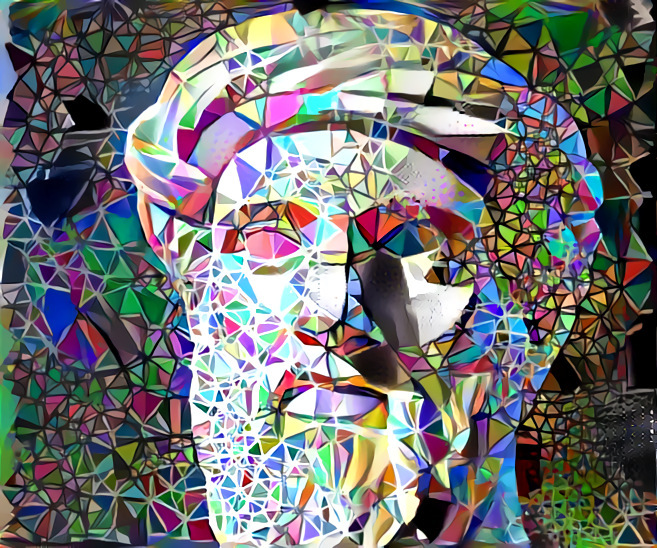
Image of Pythagoras and tesseracts remixed using Deep Dream Generator.
Introduction
During the 2017 SCOPES-DF Cohort Launch in Waltham, MA, participants were tasked with taking an existing lesson from the SCOPES-DF website, and making small improvements, adaptations, or extensions to that lesson and demonstrating the use of a digital fabrication process by making a simple artifact that reflects the improvement. Our team consisted of a SCOPES-DF team member Nettrice Gaskins, Kimberly Stanley, English teacher at STEM High School in Chattanooga, TN, and Zachary Wenz, Math teacher at MC2 STEM High School in Cleveland, OH. We were assigned the GeoConstructix lesson plan from the website.
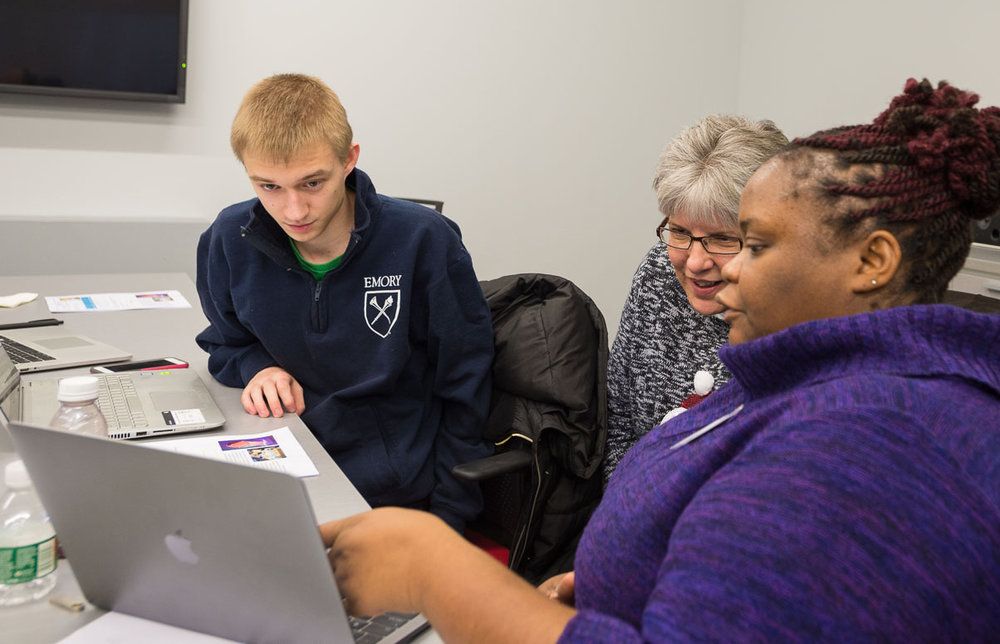
Photo © Stan Rowin stanstudio.com
A Wrinkle in Time: STEM & Digital Fabrication in Popular Culture kicked off our discussion about the connections between English Language Arts, or ELA, mathematics and digital fabrication. In summary, the overarching theme “wrinkling time” can be explored through geometry and tensegrity, which is a structural principle based on the use of isolated components in compression inside a net of continuous tension. Additionally, the main concept of time portals deals with vectors, which are geometric shapes that have both a magnitude and a direction. With vectors we were able to define operations such as addition, subtraction, and multiplication by scalars. This was the entry point for our discussion about how to remix GeoConstructix, a lesson dealing with similar concepts as tensegrity.
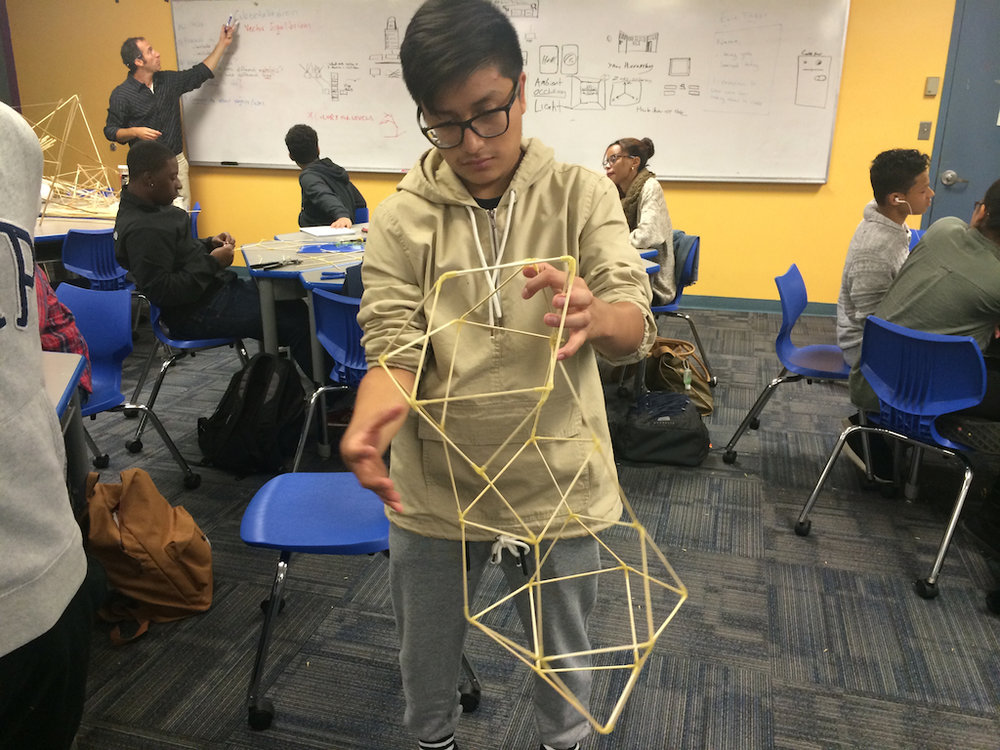
Student exploring tensegrity and a tesseract (time portal) in math class at Boston Arts Academy. Photo courtesy of Nettrice Gaskins.
GeoConstructix adapts digital fabrication concepts by focusing on the inter-relationship between geometry and computer-aided design and manufacturing (CAD/CAM) techniques. The lesson’s scaffolding structure allows students to work with a series of successive methods-based exercises that rely on both digital modeling and prototypes. By remixing this lesson, the team opened up more possibilities for exploration of general themes and concepts.
WHAT IS A “REMIX”?
Remix culture allows and encourages derivative works by combining or editing existing materials to produce a new creative work or product. The best examples of this kind of creative work are often marked by a reframing of the original narrative, and so produce a fresh perspective on both the source material and the context in which it first existed. Remixing, as a cultural practice has origins in hip hop through DJing or the live rearranging of pre-recorded music material to new compositions, and sampling or taking a portion of one sound recording and reusing it as an instrument or a sound recording in a different song.
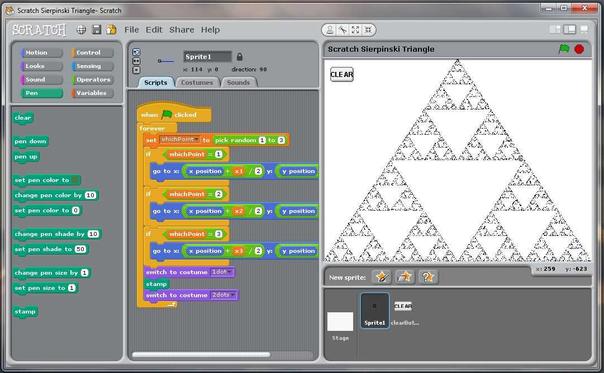
Drawing a Sierpinski Triangle with Scratch.
MIT Media Lab’s Scratch programming platform let users remix blocks of code to create their own interactive stories, games and animations. Scratching is a technique used by DJs to remix music and produce different sound effects by manipulating vinyl records on a turntable. Scratch programming takes its name from this technique, as it lets users mix together different media in creative ways. We can use methods such as remixing, sampling, and scratching when developing lessons across academic subjects.
Using the novel “A Wrinkle in Time” and other books is a great way to connect literature to STEM subjects and digital fabrication. By reading stories or books we can identify themes that cross over into other areas. “A Wrinkle in Time” provides a base for creating innovative digital fabrication projects. The next steps include remixing relevant concepts and themes using vector shapes, vector editing software and laser cutting.
Remixing GeoConstructix: A Beginning
Kimberly Stanley (STEM CHAT) had new ideas for English/ELA. As someone who has been trying to implement Digital Fabrication into her classroom, this lesson really helped her see how this can happen without causing someone a tremendous amount of stress! Not only did she see the connection with “A Wrinkle in Time”, she also saw this as an opportunity to utilize this same lesson with almost any novel/short story and the artifact could represent a time machine or portal to another world. Her students could then design their artifact to represent the time period or world they would be entering. Kimberly also saw multiple writing opportunities for the students as they collaborated with others to complete this project.
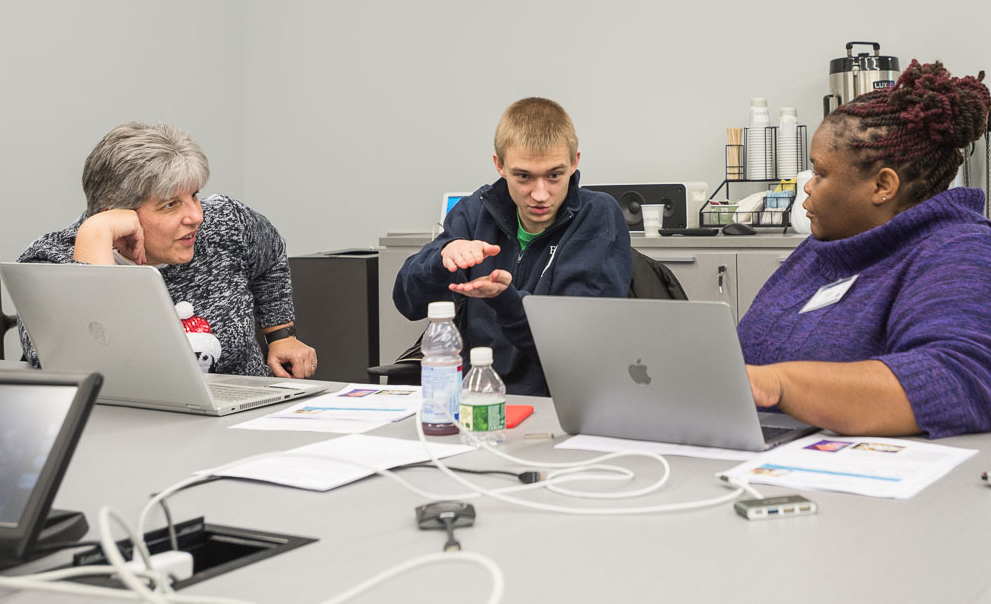
Photos © Stan Rowin stanstudio.com
Zachary Wenz (MC2), made some connections to what he is teaching, specifically using right triangles and trigonometry (Geometry). In the design of time portals students could prove theorems about triangles to including exploring how a line parallel to one side of a triangle divides the other two proportionally, and conversely; the Pythagorean Theorem proves the use of triangle similarity.

Students can use the properties of similarity transformations to establish the criterion for two triangles to be similar.
By the end of the GeoConstructix lesson, students will have learned the fundamentals of geometry and fabrication techniques with increasing levels of complexity. Students will use properties of similarity transformations and solve theorems and work out equations related to vector shapes such as triangles. In addition to geometric principles, we discussed tensegrity, specifically as a way to compress and expand a triangle or fractal-based structure to illustrate “wrinkling time.”
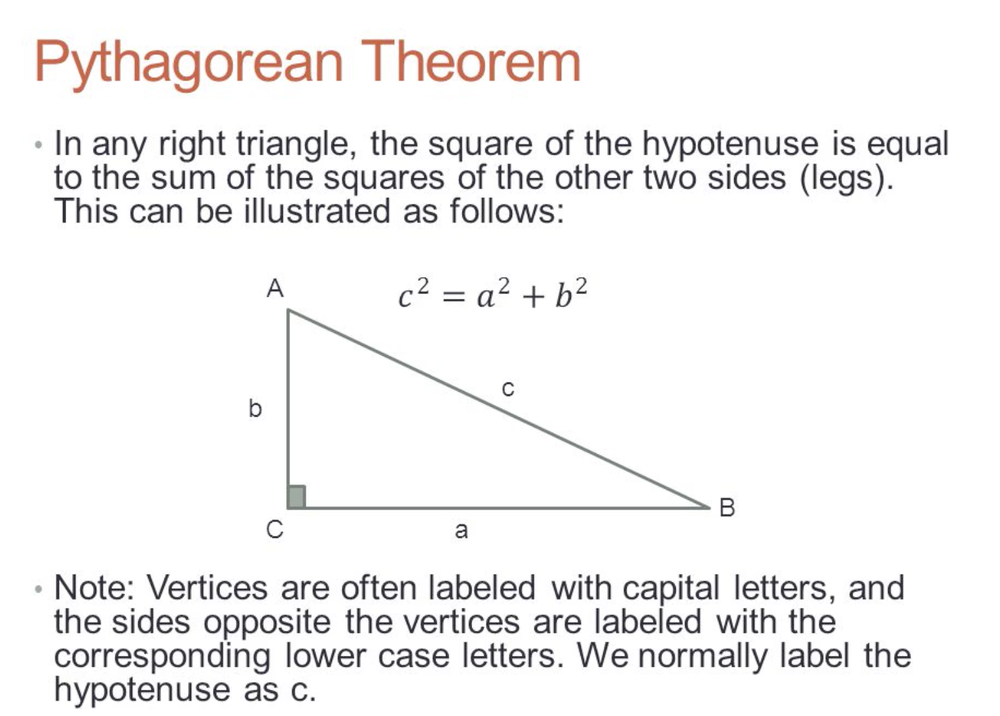
Students can solve theorems and work out equations related to triangles.
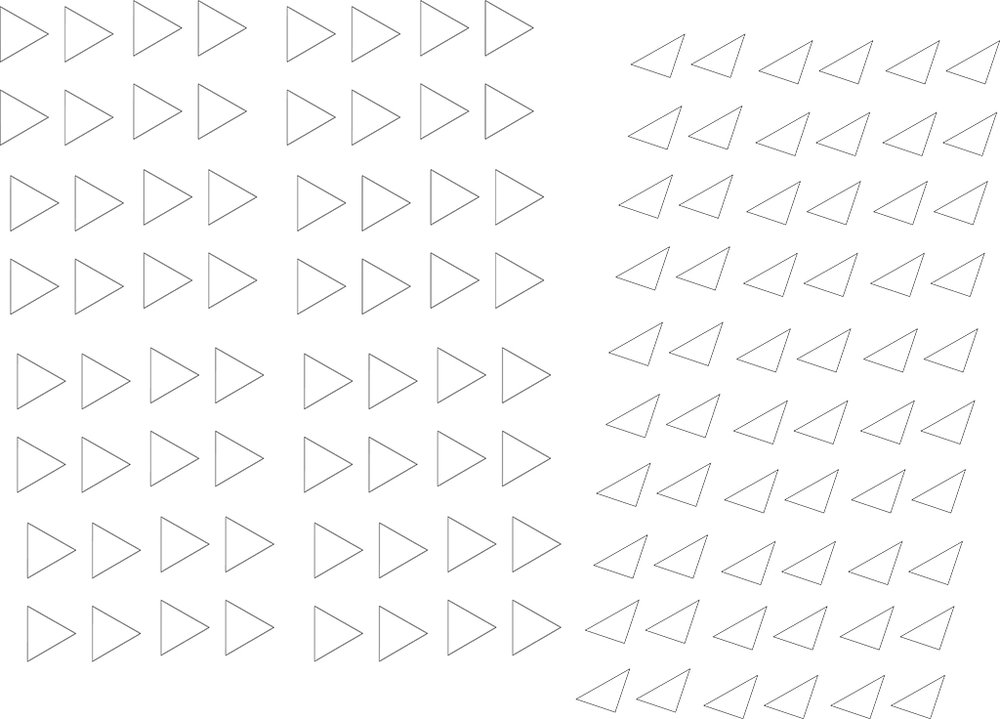
Creating triangles using vector editing software.
Based on Zach’s suggestions our group created dozens of right and equilateral triangles using a vector graphics software with the aim of laser cutting them to create a fractal-based time portal. Vector programs such as Inkscape or Illustrator allows users to compose and edit vector graphics images and save them in one of many vector graphics formats, such as EPS, PDF, WMF, SVG, or VML.
LASER CUTTING THE VECTOR SHAPES
Once the right and equilateral triangles were drawn in Illustrator, we used the correct specifications to prepare the file for laser cutting (ex. stroke/line .001 thickness). A typical commercial laser for cutting materials involves a control system (software) to generate the pattern to be cut from the material. In our case, we used a cardboard sheet. The focused laser beam is directed at the cardboard, which then burns away the lines, leaving straight edges.
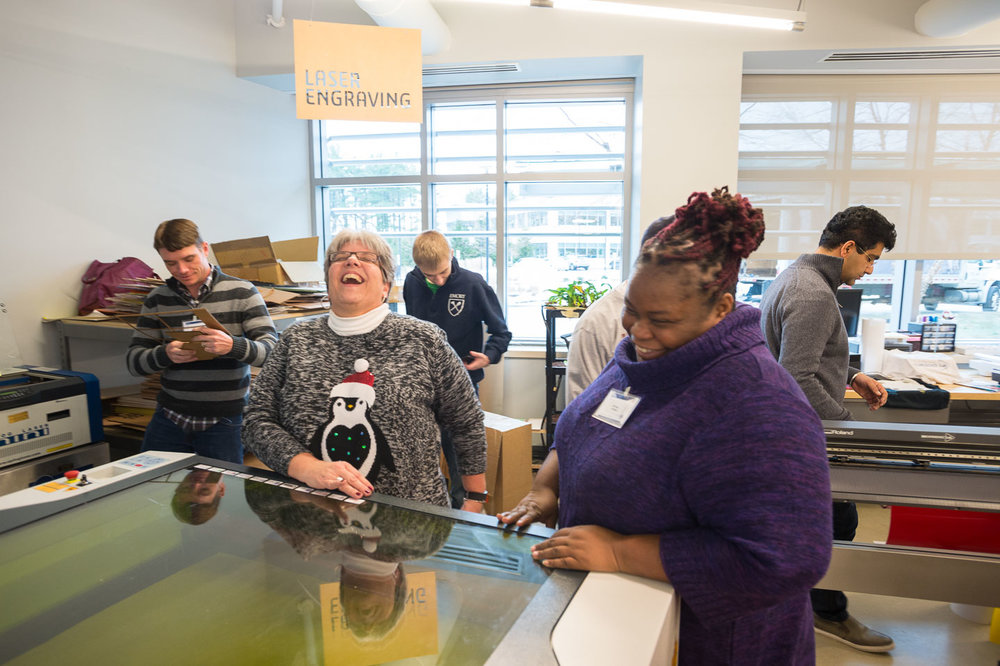
Photos © Stan Rowin stanstudio.com.
Wrinkling Time in Real Time
Madeline L’Engle, author of “A Wrinkle in Time,” studied Albert Einstein’s theory of relativity. In the book, L’Engle gives readers a peak at time travel without the mind-boggling concepts of advanced math. The 2018 film will likely give teachers and students new ideas for exploration. In addition to reading the book, or watching the film teachers can use GeoConstructix. Further, to understand “wrinkling time” teachers can instruct students to use their time portals to imagine the present at one end and the future at the other. By compressing or pressing down the structure the present touches the future creating a fifth dimension, or a tesseract, as it is referred to in L’Engle’s book, as a wrinkle in time in real time.
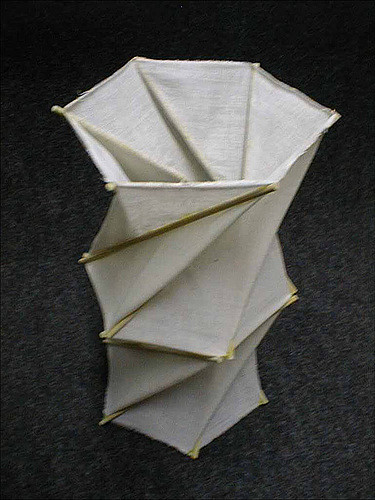
Fractal-based time portal made up of triangles
To summarize, GeoConstructix can be used to build geometric paper or cardboard time portals. As we explored in our group. this project can be used as a tool to help students read and learn the fundamentals of geometry and science. Students can build on this project to explore more esoteric concepts such as tensegrity and time travel. Although our team ran out of time before we could construct our own fractal-based time portal we did talk about ways in which students might construct one using these cross-cutting concepts.
Tagged: Digital Fabrication, English, Geometry, laser cutting, STEM
“A Wrinkle in Time” is an upcoming American science fantasy adventure film directed by Ava DuVernay from a screenplay written by Jennifer Lee, and based on the 1962 novel of the same name by Madeleine L’Engle. Several concepts from the book and film connect to STEM subjects, even digital fabrication practices.
Read MoreTagged: Digital Fabrication, Geometry, laser cutting, STEM










